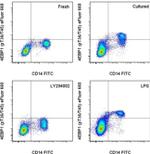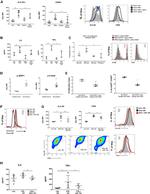Search Thermo Fisher Scientific
Invitrogen
Phospho-4EBP1 (Thr36, Thr45) Monoclonal Antibody (V3NTY24), eFluor™ 660, eBioscience™
FIGURE: 1 / 2
Phospho-4EBP1 (Thr36, Thr45) Antibody (50-9107-42) in Flow


Product Details
50-9107-42
Species Reactivity
Published species
Host/Isotype
Recommended Isotype Control
Class
Type
Clone
Conjugate
Excitation/Emission Max
Form
Concentration
Purification
Storage buffer
Contains
Storage conditions
Shipping conditions
RRID
Product Specific Information
Description: The V3NTY24 monoclonal antibody recognizes human and mouse eukaryotic translation initiation factor eIF4E-binding protein 1 (4E-BP1) when phosphorylated at threonine 37 and/or threonine 46. 4E-BP1 is a member of a family of translation repressor proteins that include 4E-BP2 and 4E-BP3. In its non-phosphorylated form, 4E-BP1 binds to the eIF4E translation initiation factor and represses cap-dependent translation. Phosphorylation of 4E-BP1 at multiple sites is necessary to disrupt this interaction and de-repress cap-dependent translation. Studies have identified several kinases that phosphorylate 4E-BP1. For instance, FRAP/mTOR phosphorylates Thr37 and Thr46, while ATM phosphorylates Ser111. Phosphorylation of 4E-BP1 at Thr37 and Thr46 is inhibited by the PI3 kinase inhibitors LY294002 and wortmannin.
Applications Reported: This V3NTY24 antibody has been reported for use in intracellular staining followed by flow cytometric analysis.
Applications Tested: This V3NTY24 antibody has been pre-titrated and tested by intracellular staining and flow cytometric analysis of stimulated normal human peripheral blood cells. This can be used at 5 µL (0.06 µg) per test. A test is defined as the amount (µg) of antibody that will stain a cell sample in a final volume of 100 µL. Cell number should be determined empirically but can range from 10^5 to 10^8 cells/test.
Protocols: Use of Protocol A: Two-step protocol for intracellular (cytoplasmic) proteins is recommended and allows for the greatest flexibility for detection of surface and intracellular (cytoplasmic) proteins. Protocol C: Two-step protocol: Fixation/Methanol may be used and allows for the greatest discrimination of phospho-specific signaling between unstimulated and stimulated samples, but with limitations on the ability to stain specific surface proteins (refer to "Clone Performance Following Fixation/Permeabilization" located in the Best Protocols Section under the Resources tab online). Use of Protocol B: One-step protocol for intracellular (nuclear) proteins is not recommended. All Protocols can be found in the "Staining Intracellular Antigens for Flow Cytometry Protocol" located in the Best Protocols Section under the Resources tab online.
eFluor® 660 is a replacement for Alexa Fluor® 647. eFluor® 660 emits at 659 nm and is excited with the red laser (633 nm). Please make sure that your instrument is capable of detecting this fluorochome.
Excitation: 633-647 nm; Emission: 668 nm; Laser: Red Laser.
Filtration: 0.2 µm post-manufacturing filtered.
Target Information
This gene encodes one member of a family of translation repressor proteins. The protein directly interacts with eukaryotic translation initiation factor 4E, which is a limiting component of the multisubunit complex that recruits 40S ribosomal subunits to the 5' end of mRNAs. Interaction of this protein with eIF4E inhibits complex assembly and represses translation. This protein is phosphorylated in response to various signals including UV irradiation and insulin signaling, resulting in its dissociation from eIF4E and activation of mRNA translation.
For Research Use Only. Not for use in diagnostic procedures. Not for resale without express authorization.
How to use the Panel Builder
Watch the video to learn how to use the Invitrogen Flow Cytometry Panel Builder to build your next flow cytometry panel in 5 easy steps.
Bioinformatics
Protein Aliases: 4E-BP1; eIF4E-binding protein 1; Eukaryotic translation initiation factor 4E-binding protein 1; MGC431; MGC4316; P/OKCL.6; PHAS-1; PHAS-I; Phosphorylated heat- and acid-stable protein regulated by insulin 1
Gene Aliases: 4E-BP1; 4EBP1; AA959816; BP-1; EIF4EBP1; PHAS-I
UniProt ID: (Human) Q13541, (Mouse) Q60876
Entrez Gene ID: (Human) 1978, (Mouse) 13685

Performance Guarantee
If an Invitrogen™ antibody doesn't perform as described on our website or datasheet,we'll replace the product at no cost to you, or provide you with a credit for a future purchase.*
Learn more
We're here to help
Get expert recommendations for common problems or connect directly with an on staff expert for technical assistance related to applications, equipment and general product use.
Contact tech support

